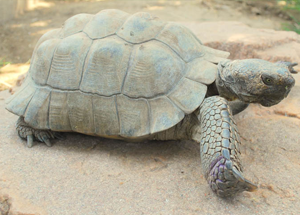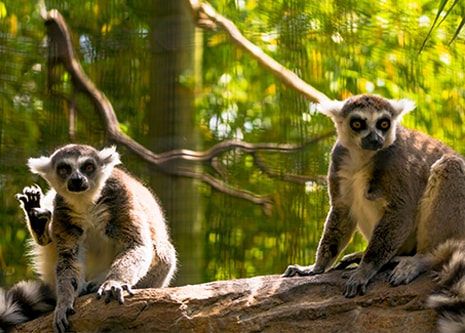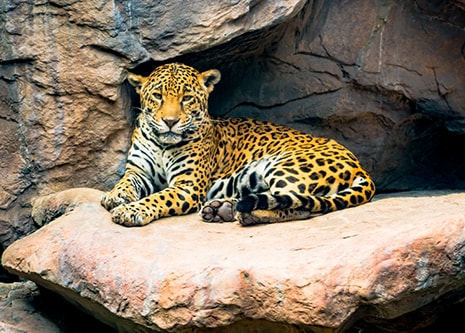
- VisitSupport Happy HollowDONATE TODAYExploreSupport Happy HollowDONATE TODAYLearnSupport Happy HollowDONATE TODAYSupport
-
Today's Hours: 10:00 am to 5:00 pm
Education AmbassadorsCalifornia desert tortoise
 Scientific name: Gopherus agassizii
Scientific name: Gopherus agassizii
Family: Testudinidae
Order: Chelonia
Class: Reptilia
Range: Mojave and Sonoran deserts of the Southwestern United States
Habitat: Desert
Lifespan: 50 to 80 yearsWhat do they look like?
Desert tortoises are slow growing reptiles, reaching 8 to 15 inches in length at adulthood. They have wide legs tipped with specialized claws which are used for digging burrows. The carapace (top shell) is rather bulky and ranges in color from light to dark brown. Desert tortoises are equipped with a gular horn, a bony protrusion at the front of the plastron (bottom shell) which males use in combat with each other.How do they behave?
Desert tortoises spend the majority of their lives in burrows. A tortoise may dig several burrows throughout its range and use them at different times of the year. These tortoises are typically active during the warmer months between March and October, and enter a state of brumation (hibernation-like state for reptiles) during the colder winter months. Desert tortoises are solitary (spending most of their lives away from other desert tortoises); however, tortoises can be concentrated in and around areas with abundant food or water sources. When this happens, it is possible for male tortoises to come into contact with one another, and fighting may occur. The fight ends when the dominant male has forced the subordinate male to retreat or when the subordinate male has been flipped onto his back.What do they eat?
Tortoises are herbivorous, unlike their omnivorous turtle cousins. A typical wild desert tortoise diet consists of grasses, cactus fruit, herbs and wildflowers. Tortoises are also capable of eating things like rocks, insects and bones. At Happy Hollow, they eat hay, fruits and vegetable greens.How are they born?
Due to their long lifespan, desert tortoises take 13 to 20 years to reach sexual maturity. Courtship and mating occur in the spring and fall. Eggs will either be laid early enough to hatch before winter, or at the beginning of the following warm season. Females lay one to two clutches per season and deposit the clutch of one to 14 eggs in a nest near her burrow. Eggs are generally the size of ping pong balls and incubate for 90 to 120 days. The temperature at which the eggs are incubated will determine the sex of the hatchlings; males result from cooler temperatures while females result from warmer temperatures. Eggs and hatchlings are often preyed upon by ravens, gila monsters, foxes, badgers and coyotes.Conservation
The California desert tortoise is listed as Vulnerable by the International Union for Conservation of Nature . Because of their threatened status, desert tortoises are protected by law, and it is unlawful to touch or collect wild individuals without a proper permit. Organizations such as the Desert Tortoise Conservancy work to prevent the further decline of this species by increasing awareness and educating the public about the role humans have played in their decline. Desert tortoise populations have struggled as a result of urban and military development, habitat destruction and habitat fragmentation (habitats that were once continuous but are now divided into smaller separate ones). The best way to help the desert tortoise is to leave them alone if you come across one in the wild; respect their space by observing from a distance.
Zoo on the Hill
Located across from the Keep-Around Carousel is the Zoo on the Hill. Learn about wildlife up close during daily meet-and-greets, leap like a lemur on the playground, brush and feed the goats,, or take a peek inside Doc’s Critter Care building and the Ranch House. Double-H Ranch features a combination of animal exhibits, including giant anteaters and red ruffed lemurs, as well chickens and domesticated animals that are docile enough to touch.
See Animals
Zoo in the Hollow
Follow the crooked bamboo pathway down into the hollow and visit with some of the most amazing animals in the world. Where else in San José can you get up close to a stunning jaguar, lemur, meerkat or American alligator? Happy Hollow is dedicated to helping save species and preserve wildlife for future generations by participating in Species Survival Plan programs through the Association of Zoos and Aquariums.
See AnimalsVisit Us Today
Plan an unforgettable experience at San Jose’s family-friendly park and zoo.
more info